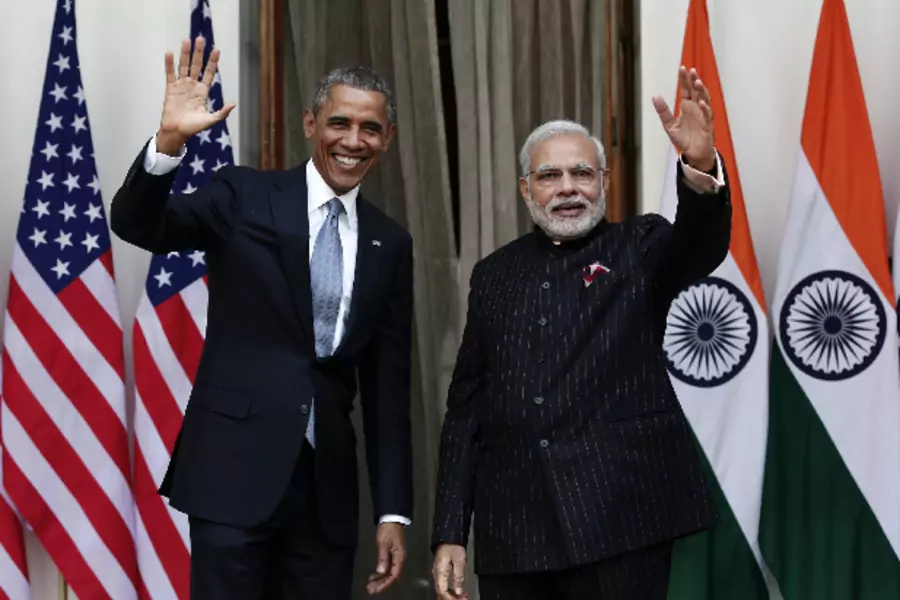Modi, Turnaround Artist: U.S.-India Ties Revived After Slump

May 26 marks the completion of Indian Prime Minister Narendra Modi’s first full year in office. Indian and international media have used the anniversary to take stock. In India, Modi has generally gotten high marks for foreign policy but some notches below that for slower than expected economic reform. The Economist devoted its cover this week to Modi (“India’s One-Man Band”) and urged more dramatic action to transform India lest the window of opportunity close.
But in all the retrospection, few analyses have addressed India’s relationship with the United States in any detail. Perhaps that’s why the opposition Congress party’s former information and broadcasting minister Manish Tewari had this to say on a popular talk show, The Big Fight:
“There is no rejuvenation of the relationship with the United States of America. You’ve not taken it to the next level, for example the NSG or the NPT…there is no energy to that relationship.” [segment begins at 19:18]
More on:
This simply does not hold true, and the portrayal hurts efforts to insulate the U.S.-India relationship from the vagaries of political change. The facts bear out that Modi, defying expectations, has approached Washington pragmatically and in the process recovered momentum for a relationship that had hit rocky shoals during late 2013 and early 2014. Are there initiatives moving slowly, or areas that still need work? Of course. But Modi deserves credit for the turnaround in ties undertaken on his watch—especially in tone, tempo, and trajectory.
Tone: Less than a year and a half ago, relations between Washington and New Delhi had ruptured over the arrest of the deputy Indian consul general, Devyani Khobragade, in New York. At a time when substantial disputes over economic matters had already rankled, the Khobragade matter plunged the relationship to a new low. Bilateral meetings stalled, and the overall atmosphere soured. Against this backdrop, many observers worried that a Modi government might view the United States with suspicion if not disfavor, given his own experience with the 2005 visa denial. Instead, Modi set a tone that moved this past aside—to the benefit of citizens in both countries. Within a few months of coming into office he made his headline visit to the United States, and four months later broke precedent by hosting President Obama as his guest at Republic Day. The bitterness of recent disputes has vanished. It has been replaced by a sense of optimism and mutual goodwill.
Tempo: It’s worth remembering how many of the promising U.S.-India initiatives seemed to simply lose steam in the last couple years of the United Progressive Alliance government. As someone then working to advance ties with India at the State Department, I certainly felt that at the time. It was hard to see a way forward on commercialization of the civil nuclear agreement; the proposed Defense Trade and Technology Initiative (DTTI) had proposals but no clear uptake; the trade bureaucracies on both sides had not met for the Trade Policy Forum in years. Each of these crucial areas under the Modi government has at last advanced to their next phases, with an agreement announced on civil nuclear commerce, a selection of DTTI projects specified, and at long last a meeting of the Trade Policy Forum last fall. It doesn’t mean everything is easy—civil nuclear commerce remains a thorny subject, and India and the United States have many disagreements on trade matters—but at least processes have again begun to move.
Trajectory: The Modi government has unambiguously signaled a desire for a close and productive partnership with Washington. That does not mean an alliance, but it has meant a willingness to signal publicly Indian interest in aligning with the United States when New Delhi finds it helpful to its own interests. Modi’s Republic Day invitation to Obama marked the symbolic expression of this process, but it is reflected in policy terms as well. For example, India and the United States have been deepening consultations on the Asia-Pacific over the course of the last five years, documented through various joint statements and remarks to the press—but it wasn’t until the Republic Day summit that New Delhi and Washington issued a “Joint Strategic Vision for the Indian Ocean and the Asia Pacific Region.”
Tone, tempo, and trajectory all matter, and it’s a credit to Modi that bilateral relations have revived after a tough period. That doesn’t mean all problems have been put to rest; there’s plenty of work ahead. It’s also true that many of the economic concerns that had so hobbled Indo-U.S. relations during 2013 and 2014 continue. Arbitrary tax enforcement and industry-specific fears about Indian intellectual property rules, for example, have kept some American investors, otherwise looking at India with renewed interest, in a wait-and-see mode. But that’s what the market mechanism means.
More on:
The good news is that these disputes can be worked on in an atmosphere free of the acrimony that hampered advances as recently as a year and a half ago. So full marks to Modi for his first year managing ties with Washington. Hope the next four bring as much promise and even more concrete gains.
Follow me on Twitter: @AyresAlyssa
 Online Store
Online Store